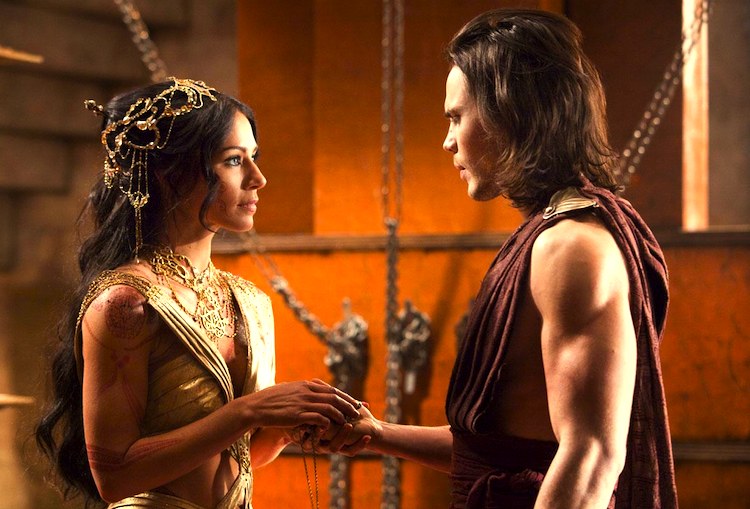
[Editor’s Note: the post below appears today on the front page of The Huffington Post and AOL-Moviefone.]
By Jason Apuzzo. I come to praise Sword & Sandal movies – not to bury them.
But with Wrath of the Titans and the Sword & Sandal/sci-fi mash-up John Carter not exactly setting the world on fire – along with recent disappointments like Immortals and Conan – it’s getting more difficult by the day to believe that the Sword & Sandal movie can survive the recent fumbling of this otherwise great genre.
And that’s a shame, because the Sword & Sandal movie – known for its gladiatorial games, pagan orgies, depraved emperors, and the occasional snarling cyclops – may represent the most colorful and enduring movie genre of all time.
So for the uninitiated, what exactly is a Sword & Sandal movie?
Like its cousin the Biblical epic, a Sword & Sandal movie – or ‘peplum,’ named after a type of ancient Greek garment – is typically set in the ancient Mediterranean world, and dramatizes the fight for freedom. Think of Kirk Douglas fighting to free slaves in Spartacus.
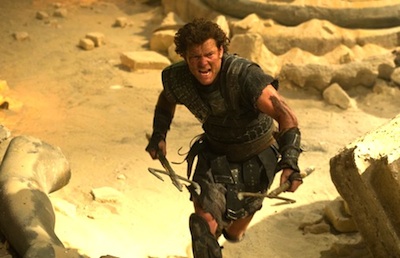
The hero of a Sword & Sandal movie is usually muscle-bound (think Steve Reeves) and able to deliver passionate speeches about freedom (think Charlton Heston). The villain is normally a wicked tyrant, preferably played by a silky British actor (think Christopher Plummer) – and the hero typically has a few slave girls, wicked queens or curvy sorceresses thrown his way before he settles down with his true love, often played by an Italian brunette (think Sophia Loren).
From as far back as 1914’s Italian epic Cabiria – the first movie ever screened at the White House – Sword & Sandal movies have been delivering huge entertainment value with their muscle men, exploding volcanoes, sacrifices to Moloch and marching Roman armies.
Cecil B. DeMille and D.W. Griffith took the genre to its early heights from the 1910s-1930s, with spectacular films like Intolerance (1916) and Cleopatra (1934). In the years before the Production Code, these films often pushed the boundaries of sex and carnivalesque violence. In DeMille’s infamous The Sign of the Cross (1932), for example, Claudette Colbert takes a sexy milk bath (see below), and the film wraps with a lurid finale featuring Amazon women fighting pygmies, and nubile Christian martyrs (including one played by burlesque queen Sally Rand) served up to gorillas and crocodiles.
Hail Caesar!
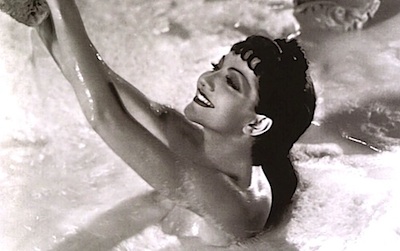
The genre’s heyday, however, was in the 1950s and early ’60s – the era of ‘Hollywood on the Tiber,’ when the studios decamped to Rome to recreate the ancient world. This period was dominated by American-made Biblical epics and Italian-made serials about Hercules or other burly, mythical heroes like Maciste. Lavish spectacles like Ben-Hur, The Robe and Quo Vadis saved Hollywood from the economic encroachments of television, and minted a new generation of masculine stars like Charlton Heston, Kirk Douglas and Richard Burton. And the movies themselves got bigger, with new formats like CinemaScope and VistaVision filling movie houses with sumptuous panoramas of ancient lands.
Capping off the era was Elizabeth Taylor’s magnificently grandiose Cleopatra (1963), a movie so big that today it would’ve cost over $330 million to produce – possibly because the film’s dubious Italian accountants claimed Liz Taylor ate twelve chickens and forty pounds of bacon each day for breakfast.
Nothing about peplum movies – not even their catering – is small.

After a long drought, broken by only a handful of films like Ray Harryhausen’s magical Clash of the Titans (1981) – and Conan the Barbarian (1982), featuring Arnold Schwarzenegger as the bone-crushing Cimmerian warlord – the Sword & Sandal genre was revived splendidly in 2000 by Ridley Scott and Russell Crowe in Gladiator. Gladiator took advantage of new digital technology to convincingly recreate the ancient world in telling a blood-soaked tale of Rome’s slide into imperial tyranny. Frank Miller’s 300 then ‘modernized’ the genre in 2006 – recreating the Battle of Thermopylae with video game-style action, post-9/11-style speeches about the value of freedom, and Gerard Butler providing the most impressive display of abs since Franco Columbu was Mr. Olympia.
Fortunately, although recent projects like Wrath of the Titans and John Carter are doing little to build off the momentum of those films, Hollywood still seems to have confidence in peplum movies. Brett Ratner and The Rock are plunging ahead with their adaptation of Hercules: The Thracian Wars, and Russell Crowe recently signed to star in Darren Aronofsky’s Sword & Sandal-esque movie about Noah. The 300 prequel Battle of Artemisia still moves forward, and Wrath of the Titans director Jonathan Liebesman wants to direct movies about Julius Caesar and Odysseus. Plus Mel Gibson’s Maccabee movie is still in development (a bit awkward, that one), Ridley Scott and Paul W.S. Anderson are both doing Pompeii projects, Angelina Jolie is still circling around an expensive Cleopatra film – and Steven Spielberg is even considering directing Gods and Kings, an epic telling of the life of Moses.
While it’s heartening that these projects are still going forward, no one wants them to suffer the same fate as John Carter or other recent, lackluster efforts. Audiences probably deserve better than what they’ve been getting, so with that in mind it’s time to take an unflinching look at what’s working – and not working – about this latest crop of Sword & Sandal movies.
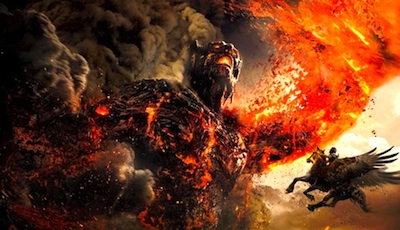
WHAT’S WORKING ABOUT THE NEW SWORD & SANDAL MOVIES:
1) Boffo Digital Creatures
Movie creatures haven’t been quite the same since Ray Harryhausen retired, but his legacy is still alive and kicking (and growling) into the digital age. Recent creatures like Wrath of the Titans‘ Kronos or the club-wielding cyclops, or the White Apes in John Carter, are awesome beasts to behold – especially in IMAX 3D and 7.1 channel sound. And whereas back in the 1950s and ’60s only Harryhausen’s movies had credible creatures (even the wonderful Italian peplum movies so often got dragged down by paper mache dragons and rubber lizards), nowadays most Sword & Sandal flicks can be expected to feature a decent mythical beast or two.
2) Great Use of Weaponry
Today’s Sword & Sandal stars like Conan‘s/Game of Thrones‘ Jason Momoa or Immortals‘ Henry Cavill (who’s also the next Superman) really look like they can fight, or at least like they’re trained and know their way around weaponry. And while that isn’t a prerequisite for peplum heroics – Tony Curtis never needed it – the ability to use a sword, spear or hammer axe convincingly is one of the key selling points of any Sword & Sandal hero.
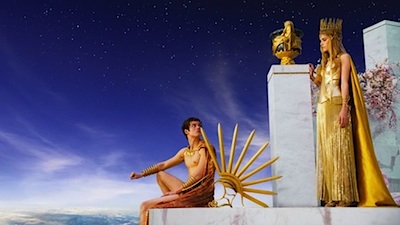
3) Bold Costumes & Production Design
Tarsem’s Immortals featured some wildly imaginative costume and production design, blending North African, Indian, Persian and Greek influences that enlivened the look of Sword & Sandal cinema for the first time in years. Plus, Disney’s John Carter managed some fabulous retro/19th century sci-fi designs, for the few people in the audience still awake after the first hour.
4) British Accents
Let’s face it: the Brits, along with the Aussies and the Irish, just sound better doing this stuff right now than their American counterparts, and are saving a lot of otherwise sub-par films. In Wrath of the Titans, for example, stodgy dialogue is routinely rescued by the redoubtable Liam Neeson and Ralph Fiennes – both of whom could probably make an ad for shaving cream seem portentous.
5) 3D & IMAX
When it comes to Sword & Sandal movies, size really does matter. And while today’s 3D/IMAX-sized movies can’t compare in scale to films like Howard Hawks’ 1955 CinemaScope epic Land of the Pharaohs (one scene in that film featured over 9,000 extras), new films like the IMAX 3D version of John Carter still offer a reasonable facsimile of what those widescreen spectacles of old were like.
WHAT’S NOT WORKING ABOUT THE NEW SWORD & SANDAL MOVIES:
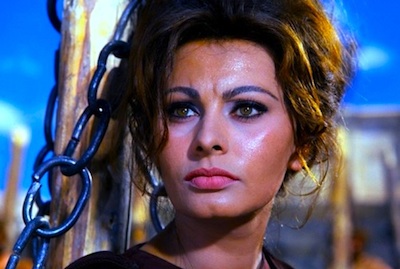
1) Where did all the Love Goddesses go?
Easily the biggest problem with today’s Sword & Sandals movies – although this is less of a problem on cable TV shows like Spartacus or Game of Thrones – is the lack of good female characters. The wicked queens, love goddesses and slave girls that once made peplum movies so famous (and scandalous) are almost completely gone – leaving little for the men in these films to do other than chop each other to pieces. No more dancing girls, pagan orgies, or virgin sacrifices – what fun is that? In the ’50s and ’60s, tantalizing (and usually Italian) women like Sophia Loren, Rossana Podesta, Gina Lollobrigida and Sylva Koscina appeared routinely in Sword & Sandal epics and made life exciting for the gods and mortal men who coveted them – or feared them. They should be welcomed back.
2) Spoiled Heroes with Super-powers and Abs
The big new trend nowadays – from peplum films to comic book movies – is to have annoying, demigod heroes with abs who fret over their supernatural powers. Petulant guys like John Carter or Perseus in Wrath or Theseus in Immortals who can’t decide whether the world is cool enough for them to save. It’s tiresome. Kirk Douglas didn’t fret over his ‘powers’ or his abs in Spartacus, Ulysses or The Vikings, probably because he didn’t have any – he just had courage (also the cinema’s best chin). Today’s peplum heroes should have fewer powers and flabbier abs (like Victor Mature), and more backbone. They should be more stoic, and stand for something beyond their own narcissism – like freedom.
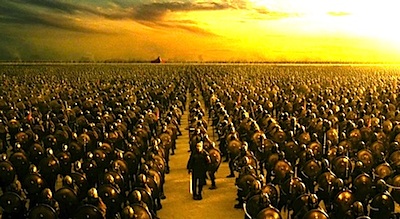
3) Fake Digital Armies
You know the kind I’m talking about, because they’re in every new Sword & Sandal film: the fake digital armies, with endless rows of digital soldiers wearing digital armor – marching and grunting into battle as one. They always appear in a scene that’s supposed to be ‘awe-inspiring,’ but that instead comes across as software-driven and phony. Memo to Hollywood: spend the money and hire some real extras.
4) Characters Who’ve Never Taken a Bath
In an effort to create ‘edgier,’ more ‘realistic’ Sword & Sandal movies, some filmmakers have come up with the idea of populating the ancient world with guys who’ve never bathed, shaved, or washed their clothes. Wrath has one such guy, an unshaven dude with matted hair named Agenor, who looks like he spent the last six months occupying Zuccotti Park. He actually gets more on-screen time than actress Rosamund Pike (seemingly the only female cast member), who plays the film’s pretty blonde heroine. A related idea in today’s peplum cinema is to have everything – buildings, armor, vegetable stands – sprayed with mud and dirt for that ‘authentic,’ antediluvian feel. It may come as a shock to some filmmakers to learn that people in the ancient world actually had access to water, and were able to wash themselves.
5) Movies That Skimp on the Big Themes: Freedom, Romance, Religious Faith
Here’s the key to a good Sword & Sandal movie: it wears its heart on its sleeve. Classics like Robert Wise’s Helen of Troy, Kirk Douglas’ Ulysses or Anthony Mann’s The Fall of the Roman Empire not only had more intelligent, literate scripts; not only were they better researched, and more faithful to the spirit of their original stories. There was also an element of sincerity and passion to them in how they depicted the big Sword & Sandal themes of freedom, romance and religious faith. In more recent years, for example, a film like 300 took the theme of freedom seriously, and cleaned-up at the box office. By contrast, I read recently that in Disney’s early meetings on John Carter, the first things executives discussed about the film were … the merchandizing and the sequels. It showed.
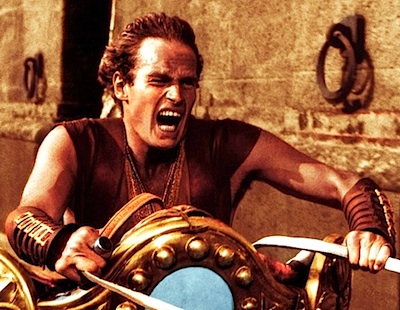
THE BOTTOM LINE:
While today’s 3D/IMAX-sized Sword and Sandal movies have modern technology and other advances going for them, they don’t always understand the human element that made classics like Ben-Hur or Spartacus work. Of course, assuming Hollywood doesn’t want more $200 million write-downs on its books, perhaps that will start to change.
The good news is that when Sword & Sandal movies are done right, people still love them. Movies about the ancient world stir our imaginations, and give us a sense of continuity with the past. They also speak to our most cherished values of liberty and faith – often while providing scandalous fun. Hollywood is right to believe in these projects – Cecil B. DeMille did, and made a career out of them for 40 years – so let’s hope filmmakers can up their game over the next few years, and make the ancient world as exciting as it used to be.
Posted on April 4th, 2012 at 8:04am.
I have always loved watching GLADIATOR. This film not only has great action, storytelling, and characterization, but it avoids many of the liberal views that many film makers have attempted to inject into many of today’s hstorical epics (ala Kingdom Of Heaven, Troy, Robin Hood, King Arthur, etc). In addition, the extended cut of the film seems to have an eerie conection to what is hapening in the word today. Allow me to explain both points (THERE WILL BE SPOILERS)
1. Maximus’ attitude toward Rome and war is not the a leftists attitude: He respects the fact the warriors of Germania will not accept defeat, but he is nonetheless determined to take down this enemy (“On my orders, prepare to unleash hell”). In addition, after the battle, when Marcus Arellius questions the validity of his regime, Rome, and the wars that have been fought, Maximus does not agree or go on some liberal babble about the pointlessness of what he has done (like in Robin Hood). Instead, Maximus angrily states that he refuses to believe what he and his men have fought and died for has been for nothing. In addition, he is a man who loves his country and when faced with the choice of turning his back on Rome due to the corruption that Marcus speaks of or taking the power of Caesar in order to rid the empire of its corruption, Maximus chooses the latter because of his love for Rome (Rome is the light). Maximus also treat his faith seriously(not with disdain), as he is constantly seen praying for guidance and that the gods watch over his family.
2. The villain, Commodus, has some eerie parallels to present day individuals. He sees himself as someone who knows better than everyone and plans on seizing all the power he can from the people. In the extended cut of the film we find out that Commodus is actively preparing to dissolve the Senate so that they cannot prevent him from going forward with his agenda. In the extended cut the audience is also told that he is secretly selling of the grain reserve to pay for the gladitorial games (His sister actually says that he is paying for his legacy with “our future”). He is ambitious, but inexperienced as a leader (“he comes in like a conquering hero, but what has he conquered?”) Commodus is not concerned with the actual troubles of Rome (the plague and sanitation) and instead wishes to hold events to celebrate his rule. He is described as a man who gains his power from knowing how to manipulate the mob and when that does not work, he uses surogates to enforce his will. Finally, while he is first loved by the people, he is soon shown to be what he truly is, which causes the people to lose faith in him, which leads Commodus to throw tantrums. WHO IS LIKE THAT TODAY?
3. The character of Senator Grachus is the “conservative old white man” who, while not as outwardly appealing or exciting to the people as the young and energetic Commodus, is the one who actually has the Roman people’s best interest at heart ( I may not be of the people, but i am for the people). He realizes that the future of Rome lies in the will of the people, not the whims of the government, and therefore works to make Rome a republic (thus inviting the Wrath of Commodus, the villain).
4. In the end, Maximus balances his personal hatred for Commodus with his desire for Rome to become a Republic, free of Commodus’ tyranny, avoiding the narcicism that exists some of today’s protagonists.In addition, the people of Rome and the viewer realize that everything Maximus has fought and sacrificed for HAS NOT BEEN FOR NOTHING (Is Rome worth one good man’s life? We used to think so. Make us believe it again.) giving hope to the Romans and the viewers. The ending of the film also avoids going down the cynical/anti-religious/ anti-spiritual route by showing Maximus being rewarded for his actions and faith by being at peace and happily joining his family in the “afterlife” (sorry atheists).
All these things tend to fly in the face of liberal themes of other such epics as TROY, Kingdom of Heaven, King Arthur, and even Ridley Scott’s own Robin Hood. Let’s not forget the creed of Gladiator: STRENGTH AND HONOR.
Thanks for your thoughts, Omar. I agree with you that there’s a lot to enjoy in the film. Personally I enjoy the film most because I’ve always been a big fan of Oliver Reed, and that was his final film …
Jason! Kudos on the article. It’s great to see you back on task with Sword and Sandals. A point you made that I like to reiterate is regarding the absence of Love Goddesses from these movies. I think a basic question they need to ask when casting the female lead(assuming they even have one) in these movies is whether the actress can stir a fourteen year old boy or looks like a fourteen year old boy. As the later was in the case of Lynn Collins from John Carter.
And omar, thank you for the outstanding perspective on Gladiator. It’s one of those movies that I never tire of watching. It’s timeless and nearly perfect.
Many thanks! I do appreciate it – and I’ve certainly been missing writing about this stuff. The timing seemed to be right with these two films coming out …
I think your test of lead actresses is a good one for this type of film (Sophia Loren, Rossana Podesta, Gina Lollobrigida and Sylva Koscina would all pass that test with flying colors) – but I actually thought Lynn Collins at least looked the part in John Carter. The problem, in my opinion, was that the entire cast had a made-for-TV quality in terms of their personalities. There just weren’t any interesting actors cutting loose anywhere. The film was fatally bland, from the first moment on.
As for Gladiator, it’s a movie I didn’t appreciate sufficiently when it first came out – but it’s aged well. Crowe is just superb, and the themes the film addresses are timeless. I still don’t think it’s as good as Fall of the Roman Empire, however, on which it was clearly modeled.
The bland personalities of the actors may have been a function of the director. This was Stanton’s first live action movie – having been an animation director prior to it. Animation directors generally rely on the animator to provide the acting and personality and he may have been out of his depth in trying to get good acting from real live people.
I think the director’s lack of experience with live actors was probably a major factor. This was really much too big a film to take on as a first effort.
Nice writeup Omar, and right on point.
Articles like this are why I love this site, especially when compared to Big Hollywood, which is run by a Sarah Palin- obsessed fool with no taste in film whatsoever. Hard to believe that Wrath of Titans was just as bad as Clash, it looks like they learned absolutely nothing from the failures of the first.
Thanks for the kind word, Sean, I appreciate it. As far as Clash goes, no, they didn’t learn much from the experience of the first film …
While I ordinarily keep a close eye on Libertas as a site which gives genuinely useful reviews, I have to dissent. First, I thought John Carter was excellent (bizarrely so do Russians and the Chinese – because Mars is the Red Planet?), despite the mildly annoying “I don’t want to fight” nonsense that the real John Carter would have viewed as weak spirited cowardice. But more importantly, while I grant that recent movies about Troy have been terrible, I also think all the old ones were too. Hollywood has never made a good film about the Trojan Wars, and I doubt they ever will because they start from several flawed premises. 1) They are always from the Trojan side, which guts all your source material as it is the Greeks who are the heroes. Paris is a contemptable coward who shrinks from a duel with Menelaus which could end the entire war (see the Illiad) and Hollywood tries to make a romantic hero out of him? 2) They expunge the Gods, without whom the entire story makes little sense unless, as they alwasy do, they make the war about grubby realpolitic which kills any mythic sense of the story. 300 was effective because despite the fact that it was about a historic event, the writer and director realized it is the myth of Thermopylae that mattered, even at the time it happened. With Troy movies, they take a myth, and turn it into a crude version of what they think the war in Iraq was about. 3) They try to cover the entire war, which is lunacy when you consider that the Illiad took place over a couple of weeks.
If somebody wants to make a movie or miniseries about Troy, switch sides, restore the gods, and portray Paris/Helen not as some grand romance, but as a creepy supernatural mind control thing, with Helen practically falling into a trance whenever Paris is present (courtesy of Aphrodite’s gift) but recovering when he isn’t and being appalled by what she has done while under the influence (to the extent she even remembers it) and focus romance on Menelaus, the dude trying to rescue his wife. But as a Classics major, I am perhaps too attached to the source material.
Andrew, I love your comments … even though you’d probably have a hard time pitching that version of the story in Hollywood! 😉
Listen, for what it’s worth I happen to love Robert Wise’s 1956 epic Helen of Troy – an almost criminally underrated classic, in my opinion – although it most certainly would not meet your criteria as being a wholly ‘accurate’ presentation of Homer’s story. Nor, I believe, did Robert Wise nor his superb production team (which included, incidentally, buddies of his like Howard Hawks doing 2nd unit work, and a young Sergio Leone as an assistant director) intend it as such. There are certain realities that need to be recognized in terms of reaching modern audiences, I’m afraid. I think that one obvious need is to focus on the love story between Paris and Helen – which, incidentally, happens to be one of the most celebrated love stories in history. Don’t fight it!
It would be nice, however, to include the gods more – I agree with you there. What that would do, however, would exponentially complicate the storyline and lengthen any film. Filmmaking is, alas, a practical exercise.
Andrew well I agree with you that the last couple movies about the Trojan War have suffered because the directors have tried too hard to draw modern parallels, keep in mind that what the Ancient Greeks would have considered to be a Hero and what we would consider in the 21st Century are quite different. Many of the Greek heroes display negative qualities that have rightly been called out by not only the Greeks but others throughout history. Yes Paris and Helen are cowardly and rightly looked down on in the myths…but remember that Achilles endangers the whole war effort because of a personal vendetta with Agamemnon. Telling the story from the Trojan side is not wholly without merit, especially when the focus is on Hector, who out of all the characters to appear in the myth surrounding the Trojan War comes across as the closest thing we in the 21st century would recognize as a hero. Hectors skill in battle, his courage and his love of country all served to elevate him in the minds of those who came after, it was Hector not Achilles who is traditionally counted among the 9 Worthies, men who were held up in the Middle Ages as the embodiment of Chivalry (or at least an aspect of Chivalry). If you already haven’t I’d suggest you give Colleen McCuollough’s novel The Song of Troy a read, it was pretty close to your vision of a Trojan War movie.
Jason loved the article.
In my opinion the Sword & Sandal genre is going to experience another down turn unless they can find a way to go back to the basics and tell a self-contained story. The worst thing to happen to any medium of storytelling was this idea that everything has to become a franchise. Alternatively the formula, well tried and true, could use a bit of a shaking up. Almost all the protagonists of recent films have been young, muscle bound men, and to the casual movie goer they run the risk of blending together in one’s mind. If the protagonist where switched up, from time to time, ether to an elderly ex-warrior or even someone like Peter Dinklage playing a version of his Game of Thrones character well the muscled young man took a supporting role could produce some interesting results.
Excellent comments across the board here, Jim. Thanks so much for contributing. And I would just underline my own agreement with you that Hector really is the figure from the Trojan War who most closely confirms to modern notions of heroism, although his story is obviously a tragic one.
Another heroic figure of this sort is, of course, Aeneas, although Aeneas’ more famous exploits came later … and in this context I’d like to recommend Steve Reeves’ two Aeneas movies: The Trojan Horse (1961) and its sequel, The Avenger (1962). They’re great fun, with a wonderful sincerity to them, even if they’re not what one would call ‘accurate’ in their re-tellings of their respective stories.
Nice roundup of titles: I’ve always liked Douglas’ VIKINGS and ULYSSES and nice to see them recognized (in a good way). I cannot think of a current genre film with a lead actor showing Douglas’ manic energy/stunts onscreen. But then a lot of modern films are so over-produced the lead action actor is a cog, a too-reduced force of energy and expression. And would they let the lead take such physical risks?
Something that would have helped JOHN CARTER is just a quick 45 minute trim: it was too long. But I can say that about most “big” films. It seems to me an 80 minute action film has a greater chance of getting you to leave the theater saying “I want to see that again” versus “Help me I’ve gone blind.”
Erik, you’re right on the nose! John Carter really needed to be much shorter. Its dramatic flaws wouldn’t have been so noticeable (the action scenes weren’t all that bad, actually), and Disney might’ve saved themselves an extra $100 million.
And you’re so right about Kirk Douglas’ energy and physical dynamism on-screen. One of my favorite bits of Douglas bravado was in The Vikings, when he climbed the axes on the drawbridge near the end. Great stuff. Also his prancing along on the Viking longboat’s oars.
As an audience member, something I really appreciated recently in this vein was Tom Cruise scaling the Burj Dubai in Mission: Impossible. Even though he was wearing a harness (can’t blame him there), the feat itself struck me as extraordinary – especially when seen in IMAX – and quite old-school, like Steve McQueen driving the Mustang in Bullitt. Stars really don’t do this sort of thing enough any more, even though it brings an element of showmanship to the proceedings that audiences really appreciate.
Cruise is epic in doing his own stuntwork. The guy’s a real professional, too, who gets a bad rap due to his eccentricities.
Agreed.
Fear not, Mr. Apuzzo. My colleague and I are hard at work on creating a biblical/sword and sandal epic that has Romans, slave girls, religion, swordplay, the siege of Jerusalem, and the elusive human element. Hopefully, we’ll be able to get it in front of the right people.
Fantastic, EMD! Please keep us updated, and remember to post any relevant links here …
“WHO IS LIKE THAT TODAY?”
George W. Bush